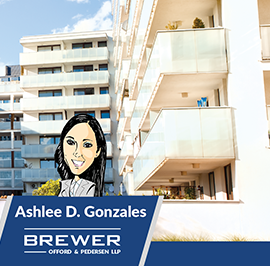With the threat of foreclosures on the rise, filing for bankruptcy is becoming more attractive to many homeowners since filing imposes an automatic stay, or legal pause button, on any action by the secured creditor to recover from the debtor. However, an action against the debtor herself is different than action against the debtor’s property.
At the time debtor files for bankruptcy, the stay automatically stops most actions against the debtor in civil litigation and actions by the creditor to obtain debtor’s property or to enforce a lien against the property. This means that a secured creditor cannot continue foreclosure proceedings, at least temporarily, once a debtor files for bankruptcy.
This automatic stay will last for the duration of the bankruptcy unless a creditor moves for relief from the automatic stay. Relief from the stay grants a creditor permission to proceed as before to recover on the debt outside of the bankruptcy courts. If the court grants a secured creditor relief from the stay, the creditor has, for example, permission to proceed with a foreclosure against debtor’s property.
Debtor and the Bankruptcy Estate
When she first files for bankruptcy, the automatic stay protects both the debtor and the debtor’s property. The debtor’s property becomes property of the bankruptcy estate. The bankruptcy estate can be thought of as all of the property the debtor owns; just like when you loaded up your car and first moved out of your parents’ house. In bankruptcy, that car and everything in it is the bankruptcy estate since it has all of the property you own packed inside.
When the debtor files for bankruptcy it’s like she drives that car to the bankruptcy parking lot and parks it under cover for the duration of the case. The government bankruptcy lot is guarded and locked and will protect debtor’s car and its contents from the rain, snow, sun, and creditor requests for payment. It will also protect the debtor from most civil liability if she stays inside the parked car. Depending on the bankruptcy chapter, only the debtor and the bankruptcy trustee may touch the contents of the estate and only for certain purposes.
Repeat Filings
A bankruptcy case ends with either a dismissal or a discharge. A debtor can be dismissed from bankruptcy and lose her bankruptcy protection for a number of reasons, most often ordered after a debtor has failed to file certain documents or otherwise abide by court procedures. This is true regardless of the chapter of bankruptcy filed. A discharge occurs at the conclusion of the bankruptcy proceeding, when the estate has been reorganized and the debtor is released from certain obligations.
While a discharge in bankruptcy relieves the debtor of liability to pay back certain loans, a dismissal from bankruptcy essentially sends the debtor and her bankruptcy estate out of the parking lot on her own, free from any governmental protection from creditors. When facing a foreclosure and dismissed from bankruptcy, the debtor may have only stalled for time in the home and is not in a better position than previous to the filing. She likely still wants the protection that being able to park in the bankruptcy lot afforded her.
Prior to the Bankruptcy Abuse Prevention and Consumer Protection Act of 2005 (“BAPCPA”), debtors could file repeatedly in order to remain within the protection of the bankruptcy courts, thereby frustrating creditors’ attempts to recover what was owed. The debtor could simply keep driving in and out of the bankruptcy parking lot. For the secured creditor, these repeat filings were a frustrating delay tactic to postpone foreclosures with repeated stops and starts to the statutory nonjudicial foreclosure clock.
BAPCPA in its current form includes two provisions that curtail the protection offered to debtors in bankruptcy.
Second Filing With a Bankruptcy Case Pending Within A Year
If a debtor has had a bankruptcy case pending and dismissed within the past year, the automatic stay in the second bankruptcy only lasts for 30 days in favor of the debtor. This means that the protection she enjoyed from civil judgments or wage garnishments while in her first bankruptcy will not continue to protect her, unless she files a request in good faith for an extension of the stay.
However, the 30 day automatic stay in the second bankruptcy only ends as against the debtor herself; the 30 day limitation does not apply to the bankruptcy estate. Provided there is no extension granted to extend the automatic stay, after a second filing the debtor is no longer allowed to sit in her car in the bankruptcy parking lot. However, that loaded up car stays in the bankruptcy parking lot until the secured creditor asks the court for relief from the stay.
Thus, in order for a secured creditor to obtain relief from an automatic stay in bankruptcy, they must always request relief from the automatic stay from the court before proceeding to a foreclosure sale—regardless of the fact the debtor has had a bankruptcy case pending in the year prior to the current case.
Third Bankruptcy Filing with a Case Pending and Dismissed Within A Year
Yet, if the debtor is dismissed from the second bankruptcy and again files for a third time within one year, there is no automatic stay. It never arises, by operation of law, in the case of this third successive filing. Therefore, the debtor doesn’t get to park her car in the lot at all, not even for an afternoon. She and her car remain at the mercy of the weather and at the mercy of her creditors. (The cautious secured creditor seeking to foreclose during a third filing will ask the court not for relief from the automatic stay but for a comfort order confirming that the stay has terminated.)
While the 2005 BAPCPA changes to the bankruptcy code continue to grant a debtor protection from creditors, the changes also now refuse to allow a repeat filer to use the filings as a stall tactic for very long. As frustrating as it is to be a secured creditor in a foreclosure proceeding, there is hope for relief from the automatic stay no matter how many times the debtor files for bankruptcy protection.
Amanda is with Brewer Offord & Pedersen LLP. The firm serves the legal needs of homeowners, real estate and mortgage brokers, agents, brokerages, title companies, developers, investors, other real estate professionals and their clients. Mr. Brewer and his firm also represent clients in debt collection, breach of contract matters, and other litigation and transactional work. The firm’s client range from homeowners, brokers and lenders based in Santa Clara County, San Mateo County, San Francisco County, as well as throughout other counties in California.




